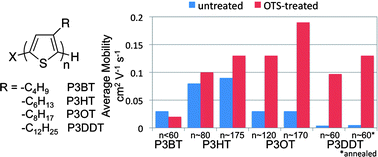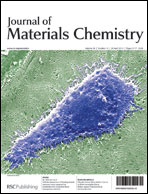In this paper, the effect of side chain length on transistor performance was analyzed by using a series of well-defined, regioregular poly(3-alkylthiophene) (P3AT) samples (with PDI values as low as 1.1). Both untreated and octyltrichlorosilane-treated (OTS) SiO2 transistor dielectric layers were compared for all samples. On untreated SiO2, P3AT with hexyl side chains showed the best mobility, with mobilities as high as 0.1 cm2 V−1 s−1, and mobility values then decreased slightly with longer side-chain length. When using OTS-8 treated SiO2, on the other hand, mobility values remained high even with polymers of longer side-chain length, obtaining mobilities as high as 0.2 cm2 V−1 s−1 for hexyl, octyl and dodecyl side chains, which were much higher than previously reported values. Carrier mobilities of P3ATs with longer side chains were seen to be more sensitive to surface chemistry than for P3ATs with shorter side chains. Using morphological and GIXS studies, we found that for longer side chains, self-assembly is governed by two competing processes—backbone packing (π-stacking) and side-chain packing—that resulted in polymorphic behavior and disorder. On an OTS-treated surface, interactions between dielectric surface and side chains were reduced, resulting in better order at the interface and higher mobility.

You have access to this article
 Please wait while we load your content...
Something went wrong. Try again?
Please wait while we load your content...
Something went wrong. Try again?


 Please wait while we load your content...
Please wait while we load your content...